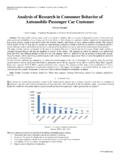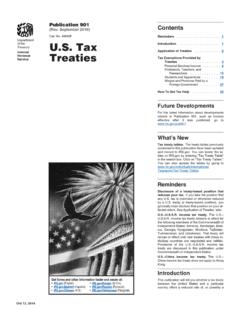Transcription of CAR PURCHASE TAX: GREEN TAX REFORM IN ISRAEL
1 CAR PURCHASE TAX: GREEN TAX REFORM IN ISRAEL2016 CAR PURCHASE TAX: GREEN TAX REFORM IN ISRAEL2016 Unclassified ENV/EPOC/WPIEEP(2016)4/FINAL Organisation de Coop ration et de D veloppement conomiques Organisation for Economic Co-operation and Development 30-Jun-2016 _____ English - Or. English ENVIRONMENT DIRECTORATE ENVIRONMENT POLICY COMMITTEE Working Party on Integrating Environmental and Economic Policies CAR PURCHASE TAX: GREEN TAX REFORM IN ISRAEL For further information, please contact Nils Axel Braathen; tel: +33 (0) 1 45 24 76 97; email: JT03398850 Complete document available on OLIS in its original format This document and any map included herein are without prejudice to the status of or sovereignty over any territory, to the delimitation of international frontiers and boundaries and to the name of any territory, city or area.
2 ENV/EPOC/WPIEEP(2016)4/FINAL Unclassified English - Or. English Cancels & replaces the same document of 29 June 2016 ENV/EPOC/WPIEEP(2016)4/FINAL 2 NOTE FROM THE SECRETARIAT1 This case study of the Israeli tax on motor vehicle purchases has been prepared by Victoria Roshal (independent consultant) and Alfred Tovias (The Hebrew University of Jerusalem).2 The paper has been endorsed for declassification by WPIEEP and is intended to be issued as a General Distribution document, and to serve as input for a shorter OECD Environment Policy Paper. This work is part of an initiative aiming at putting forward countries best practices, encouraging exchange of experience.
3 The preparation of the case study was managed by Nils Axel Braathen, under the supervision of Nathalie Girouard. The work was financed by a voluntary contribution kindly provided by the Ministry of Environmental Protection in ISRAEL . Copyright OECD, 2016 Applications for permission to reproduce or translate all or part of this material should be addressed to: Head of Publications Service, OECD, 2 rue Andr -Pascal, 75775 Paris, Cedex 16, France. 1. This document and any map included herein are without prejudice to the status of or sovereignty over any territory, to the delimitation of international frontiers and boundaries and to the name of any territory, city or area.
4 The statistical data for ISRAEL are supplied by and under the responsibility of the relevant Israeli authorities. The use of such data by the OECD is without prejudice to the status of the Golan Heights, East Jerusalem and Israeli settlements in the West Bank under the terms of international law. 2. The authors are extremely grateful to Boaz Soffer, former Deputy Director for Planning and Economy of the Israeli Tax Authority, Galit Palzur and Amir Zalzberg of the Ministry of Environmental Protection for the time they took to explain and clarify certain points regarding the making of the tax.
5 Special thanks to Natalia Mironichev of the Israeli Tax Authority for her patience, expertise and data provision. The authors would like to also thank Prof. Nir Becker and Itamar Milrad for their responsiveness and help. This paper benefited from comments and suggestions provided by Johanna Arlinghaus, Nils Axel Braathen, Luisa Dressler, Florens Flues, Michelle Harding and Kurt Van Dender. The authors would like to acknowledge the incredible support of Nils Axel Braathen who oversaw the completion of this project. ENV/EPOC/WPIEEP(2016)4/FINAL 3 EXECUTIVE SUMMARY The car tax in ISRAEL has been historically the highest compared to any other country in the world, except for Denmark.
6 This was one of the reasons for the lowest rate of motorisation among the OECD countries, increased amount of older cars on the roads, which also meant the vehicles were both less safe and emitted more pollution. Cars were considered a luxury that only the better off could afford. In December 2005, a plan for a gradual tax reduction was introduced: the PURCHASE tax was to be reduced from its original level of 95% in 2005 to 72% in 2010. Alongside, in an attempt to tackle the environmental effects from motor vehicles, ISRAEL adopted European and US emission standards (since the mid-1990s), initiated several scrappage schemes, tightened annual emission tests and introduced roadside spot checks.
7 These measures have been important in reducing negative effects of transportation, but still did not tackle the fact that the marginal cost to society of using a car is much more significant than the tax paid on it. Pollution, noise, congestion coming from an ever-increasing number of vehicles all these negative effects are being experienced by the whole society, however, only the car owners enjoy the benefits. Without a tax differentiation based on different level of emissions, there was no incentive to PURCHASE greener cars.
8 In August 2009, the recommendation of an inter-ministerial commission to implement a GREEN REFORM came into effect, resulting in the vehicle PURCHASE tax being adjusted according to 15 pollution grades, calculated by weighing all relevant and measureable emissions (NOx, CO, PM, HC and CO2) according to their harmful impacts, derived from each pollutant s relative cost to society. The goal was to create a differentiation between various levels of emission, while keeping tax revenues unchanged. New tax incentives to favour vehicles with enhanced safety mechanisms were also introduced.
9 This created incentives for reducing average health-related and greenhouse gas (GHG) emissions. Public revenues increased (by 12%) in the first two years after the tax implementation, mainly because of an increased number of cars being sold. However, revenues dropped in the following years (by 11% in 2012-13 compared to 2010-11) due to the significant change in the composition of the new fleet of vehicles, with fewer high-pollution ones being sold. In 2013, following the decreased share of polluting vehicles, which resulted in an erosion of the tax base, the tax formula was updated to enhance even more the reduction of emission volumes, and to increase public revenues.
10 The formula will continue to be adjusted every two years. While the net effect of the REFORM was an increase in total emissions from new cars, its most important outcome was that it managed to reduce average CO2 emissions (per car) without increasing harmful health-related pollution, particularly NOX and PM, contrary as was the case in many EU countries, where tax incentives, based solely on CO2 emissions, caused a dangerous increase in local air pollution. Unlike in the EU, the REFORM has not increased relative demand for diesel vehicles (which tend to emit less CO2 but more local pollutants than petrol cars).















